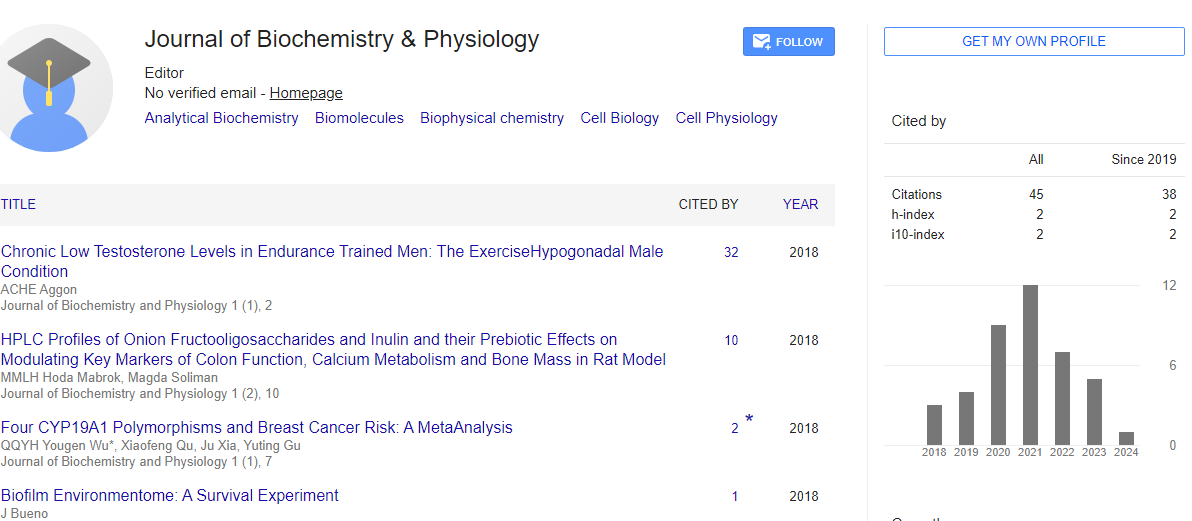Commentary, J Biochem Physiol Vol: 7 Issue: 4
Targeting Cell Signaling Pathways for the Treatment of Cardiovascular Diseases
Alzara Tomin*
1Department of Physiology, University of Tubingen, Geschwister-Scholl-Platz, Germany
*Corresponding Author: Alzara Tomin,
Department of Physiology, University of
Tubingen, Geschwister-Scholl-Platz, Germany
E-mail: tominal@zara.edu201.com
Received date: 23 November, 2024, Manuscript No. JBPY-24-154541;
Editor assigned date: 25 November, 2024, PreQC No. JBPY-24-154541 (PQ);
Reviewed date: 09 December, 2024, QC No JBPY-24-154541;
Revised date: 17 December, 2024, Manuscript No JBPY-24-154541 (R);
Published date: 24 December, 2024, DOI:10.4172/jbpy.1000181.
Citation: Tomin A (2024) Targeting Cell Signaling Pathways for the Treatment of Cardiovascular Diseases. J Biochem Physiol 7:4.
Description
Cardiovascular Diseases (CVDs) are among the leading causes of injury and death worldwide. These conditions involves a wide range of disorders, including coronary artery disease, heart failure, hypertension and atherosclerosis, all of which contribute significantly to global healthcare burdens. Recent advances in molecular biology have highlighted the critical role of cell signaling pathways in the pathogenesis of CVDs and targeting these pathways offers new therapeutic opportunities to improve cardiovascular health. Understanding the molecular mechanisms essential cardiovascular dysfunction is essential for designing more precise and effective treatments. Cell signaling pathways regulate essential cellular functions such as proliferation, differentiation, apoptosis and metabolism. In the context of cardiovascular diseases, these pathways control processes like vascular tone, smooth muscle cell contraction, endothelial cell function and the inflammatory response. Dysregulation of these signaling pathways can lead to pathological changes in the heart and blood vessels, driving the progression of CVDs.
One of the most well-studied cell signaling pathways involved in cardiovascular disease is the Renin Angiotensin Aldosterone System (RAAS). The RAAS plays an important role in regulating blood pressure, fluid balance and vascular tone. In conditions such as hypertension and heart failure, the RAAS is often hyperactivated, leading to vasoconstriction, sodium retention and increased blood pressure. Targeting components of the RAAS, such as Angiotensin Converting Enzyme (ACE) inhibitors and Angiotensin Receptor Blockers (ARBs), has proven effective in managing hypertension and heart failure by reducing blood pressure and decreasing the risk of adverse cardiovascular events.
Another key pathway implicated in cardiovascular disease is the PI3K-Akt signaling pathway, which regulates cell survival, metabolism and angiogenesis. This pathway is involved in endothelial cell function, vascular remodeling and the response to growth factors like Vascular Endothelial Growth Factor (VEGF). Dysregulation of the PI3K-Akt pathway has been linked to endothelial dysfunction, a characteristic of atherosclerosis and other cardiovascular conditions.
The Wnt/β-catenin signaling pathway has also gained attention in cardiovascular disease research. This pathway plays a role in regulating endothelial cell function, vascular smooth muscle cell proliferation and cardiac remodeling. Abnormal activation of the Wnt/β-catenin pathway is associated with pathological vascular remodeling and fibrosis, which can contribute to the progression of heart failure and hypertension. Researchers are investigating the potential of Wnt signaling inhibitors as therapeutic agents to prevent or reverse adverse vascular remodeling and fibrosis in CVDs.
Sirtuins, a family of NAD+ dependent deacetylases, have emerged as important regulators of cellular stress response, inflammation and metabolism. Sirtuins play a role in maintaining vascular homeostasis, improving endothelial function and protecting against oxidative stress. In CVDs, such as atherosclerosis and ischemic heart disease, sirtuins are often dysregulated, contributing to endothelial dysfunction and myocardial injury. Activating sirtuins through small molecules or lifestyle interventions, such as caloric restriction or exercise, has shown promise in preclinical studies as a potential therapeutic strategy for improving cardiovascular health and reducing the risk of atherosclerosis and heart failure.
Conclusion
Targeting cell signaling pathways offers significant promise for the treatment of cardiovascular diseases. By understanding the complex molecular mechanisms that underlie cardiovascular dysfunction, researchers are identifying new therapeutic targets that can modulate key signaling pathways involved in inflammation, vascular remodeling and cell survival. While many of these therapies are still in the experimental stages, ongoing research into cell signaling and its role in cardiovascular diseases may ultimately lead to more effective and personalized treatments, offering hope for improved outcomes for patients suffering from CVDs.
 Spanish
Spanish  Chinese
Chinese  Russian
Russian  German
German  French
French  Japanese
Japanese  Portuguese
Portuguese  Hindi
Hindi 